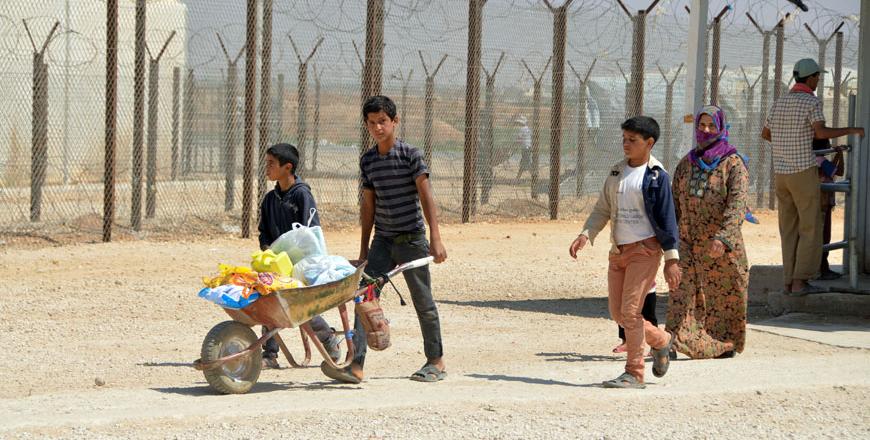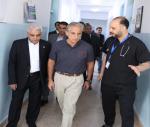You are here
Azraq camp dwellers suffer, awaiting ‘more world attention’
By Suzanna Goussous - Dec 27,2015 - Last updated at Dec 28,2015

In this file photo, Syrian refugees fill water from taps located outside the Azraq camp (Photo by Muath Freij)
AMMAN — Azraq camp for Syrian refugees is facing “harsh conditions” with an increasing number of daily voluntary returns to Syria, due to lack of facilities, said the Care International acting team leader at the camp, Jameel Dababneh.
The camp opened in April 2014, as the second biggest camp after the Zaatari camp. Last week, the camp was hosting around 28,589 Syrian refugees, according to the UNHCR.
Aoife McDonnell, associate external relations officer at UNHCR Jordan, said the camp’s capacity is 50,000, and is expandable up to 130,000.
Dababneh said the camp is divided into four villages, only two of which are populated.
In terms of utilities, he said the camp “has no electricity… and the vast space of the camp hinders access to services and facilities”, such as the only outlet for food and grocery items in the camp.
The UN refugee agency's liaison officer, Ali Bibi, said the reason for the insufficient facilities inside the camp is the lack of attention to the Azraq camp by the international community and the media.
According to McDonnell, the World Food Programme (WFP) provides refugees with food coupons, debit and e-cards, which they can use to buy food from the Sameh Mall in the camp. WFP also distributes four loaves of bread per individual daily.
WFP undertakes the provision of daily meals to the refugees, paying each JD20 a month to buy their needs, according to Shaza Moghraby, WFP’s spokesperson.
“Enough is never enough… we get complaints and we know how [high] the prices are in Jordan; prices in Syria were much lower… The refugees are still in shock,” she said.
“Four pieces of bread for each refugee, amounting to a total of 350,000 pieces of bread distributed in the camp every day, make survival a possibility,” she told The Jordan Times.
Since the beginning of the year, WFP has been facing funding shortages, the spokesperson told The Jordan Times, adding that starting December, the allowance for each individual amounted to JD15 instead of JD20.
The JD5 will cover the shortages in the camp, and the allowance for refugees will stay at JD15 until May 2016 at this rate of funding, she said.
“The shortage in funding is due to multiple factors,” Moghraby said, explaining that one of the major reasons is that the crisis has been ongoing for five years, “and is still an emergency”, while the other crises that have emerged in the region have led to the current dire situation.
The UNHCR office said an average of 52 babies are delivered in the camp and the average mortality rate is two individuals a month.
Dababneh added that the camp has also witnessed some “complicated health cases”, stressing on the essentiality of electricity.
“Electricity is not luxury; it is vital for health, protection and security,” Dababneh noted.
Due to these circumstances, there has been a steady number of voluntary returns to Syria, he said.
The average cases of return amount to almost 200 per month, UNHCR officials said.
The UNHCR, in partnership with the government, is working on establishing a solar electrical system to generate electricity in the camp.
“An extensive electrification plan of the camp has been approved and will begin early 2016 along with a solar power plant that will cover the electricity needs of the camp,” McDonnell told The Jordan Times.
“This project will make a huge difference to the many families in Azraq Camp.”
On a positive note, Moghraby said WFP launched a mobile application in cooperation with Google Play, where users can donate a meal with a click for one Syrian family living in camps.
“Share the Meal” is a mobile application launched last month, and [anyone] can donate $0.50 per click for a meal… Over a million meals have been donated since November 2015, she added.
Around 19 international and one national organisations were working in Azraq camp on November30, 2015, the UNHCR official said.
Moghraby voiced hope that “more stable and predictable” sources of funding would cover the camp’s needs.
“Children are the future, we have to make sure we don’t have a ‘lost generation’, and focus on schools so when these children go back to Syria, they [would be able to] contribute to rebuilding their country,” Moghraby said.
Related Articles
AMMAN — Chinese Ambassador to Jordan Pan Weifang and Representative of the World Food Programme (WFP) Magee Yahia on Wednesday celebrated th
AMMAN — The World Food Programme (WFP) announced on Wednesday that it has sufficient funding to provide food assistance to 526,000 vulnerabl
AMMAN — The World Food Programme (WFP) said on Tuesday that its financial status this year is better than previous years, thanks to the resp

















